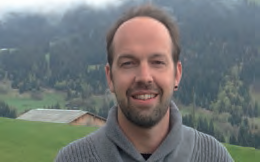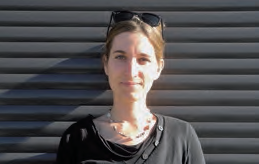MAS LA Alumni
In 2013, the Master of Advanced Studies in Landscape Architecture (MAS LA) has been running for 10 years – with over 100 graduates. Most of our graduates have moved onto jobs in important landscape architecture offices in Switzerland, Europe and beyond.
What some of our MAS LA Alumnis say:
 IOULIA GOULA : The decision to complete a Masters degree at ETH came at an important crossroads of my life. I knew I wanted to expand my knowledge base and take my theoretical skills to the next level. When studying abroad, one cannot be certain what to expect. Having said that, the MAS LA program not only fulfilled my expectations but surpassed them. This program proved to be an ideal transition from theory to practice. It complemented my knowledge with the tools necessary to understand, develop and apply my skills to the practical aspects of professional practice. It helped me enrich my perception of landscape architecture and broaden my horizons with concrete applications. Apart from elevating myself academically, after completing the program I was able to position myself in an increasingly competitive market with the appropriate skill set to meet the highest standards required. I am extremely pleased to say that to this day, I am successful in facing the challenges ofmy working environment and am able to engage in all our projects with confidence. Last but not least, during the MAS LA program I had the opportunity to build strong relationships with colleagues and faculty that I will always cherish.
IOULIA GOULA : The decision to complete a Masters degree at ETH came at an important crossroads of my life. I knew I wanted to expand my knowledge base and take my theoretical skills to the next level. When studying abroad, one cannot be certain what to expect. Having said that, the MAS LA program not only fulfilled my expectations but surpassed them. This program proved to be an ideal transition from theory to practice. It complemented my knowledge with the tools necessary to understand, develop and apply my skills to the practical aspects of professional practice. It helped me enrich my perception of landscape architecture and broaden my horizons with concrete applications. Apart from elevating myself academically, after completing the program I was able to position myself in an increasingly competitive market with the appropriate skill set to meet the highest standards required. I am extremely pleased to say that to this day, I am successful in facing the challenges ofmy working environment and am able to engage in all our projects with confidence. Last but not least, during the MAS LA program I had the opportunity to build strong relationships with colleagues and faculty that I will always cherish.
 ALEXANDRE ROULIN : After five years working as a landscape architect in Switzerland, I realized that the digital tools I was using in my day-to-day work were limited and did not allow me to improve my design skills. In the MAS LA program, I became aware of the necessity to approach landscape projects in a 3D way, to understand its whole potential and complexity. It may sound radical, but I think that drawing sketches on tracing paper belongs partly to the past. Even though I still may use “conventional” techniques, I will first investigate the terrain in all its complexity by using the 3D tools and techniques I learned during the MAS LA. The manner in which to apply them in real practice is often still broad and not yet well defined. However, during my final synthesis module of the MAS LA program I could apply the taught techniques and tools within a “Agglomeration Project” and in landscape planning. I believe that the freshness and the accuracy of the output, especially the visualizatios will be really convincing for a presentation to a city or regional council.
ALEXANDRE ROULIN : After five years working as a landscape architect in Switzerland, I realized that the digital tools I was using in my day-to-day work were limited and did not allow me to improve my design skills. In the MAS LA program, I became aware of the necessity to approach landscape projects in a 3D way, to understand its whole potential and complexity. It may sound radical, but I think that drawing sketches on tracing paper belongs partly to the past. Even though I still may use “conventional” techniques, I will first investigate the terrain in all its complexity by using the 3D tools and techniques I learned during the MAS LA. The manner in which to apply them in real practice is often still broad and not yet well defined. However, during my final synthesis module of the MAS LA program I could apply the taught techniques and tools within a “Agglomeration Project” and in landscape planning. I believe that the freshness and the accuracy of the output, especially the visualizatios will be really convincing for a presentation to a city or regional council.
 TASOS ROIDIS : Studying in the ETH MAS LA program helped me integrate new technology tools in my workflow. From analysis, to editing and visualization of ideas, concepts and models, both for landscape and architectural projects. After graduating I have worked in the ETH for the Reactivate Athens project with Urban Think Tank where I had the chance to apply many of these tools. As an individual architect, I participate in major competitions where I integrate many of the analysis methods and programming techniques in order to optimize the outcome of my work and produce a high quality result.
TASOS ROIDIS : Studying in the ETH MAS LA program helped me integrate new technology tools in my workflow. From analysis, to editing and visualization of ideas, concepts and models, both for landscape and architectural projects. After graduating I have worked in the ETH for the Reactivate Athens project with Urban Think Tank where I had the chance to apply many of these tools. As an individual architect, I participate in major competitions where I integrate many of the analysis methods and programming techniques in order to optimize the outcome of my work and produce a high quality result. CLAUDIA ARACCI : Having already worked in the field of landscape architecture I decided to join the MAS LA to experience a new way of designing land and territory. In fact I was able to improve my design skills and graphics by integrating advanced software tools for analysis, research and visualizations up to parametric design, which was a totally new discovery for me. The MAS LA also gave me the opportunity to examine some theoretical and historical topics of landscape architecture in-depth. During my final synthesis project I concentrated on landscape infrastructure as I was especially interested in the Swiss mobility network system in the large scale. Once back in my home country of Italy, I felt pushed to find a job in the domain of civil engineering as landscape is a crucial element in the design of infrastructure. 3D tools have become part of my everyday work: GIS as an analysis tool for urbanism, visualization software for 3D views and perspectives, and Rhino to create fast topographical models and video for animated presentations Landscape architecture understood at all scales has become part of my way of designing.
CLAUDIA ARACCI : Having already worked in the field of landscape architecture I decided to join the MAS LA to experience a new way of designing land and territory. In fact I was able to improve my design skills and graphics by integrating advanced software tools for analysis, research and visualizations up to parametric design, which was a totally new discovery for me. The MAS LA also gave me the opportunity to examine some theoretical and historical topics of landscape architecture in-depth. During my final synthesis project I concentrated on landscape infrastructure as I was especially interested in the Swiss mobility network system in the large scale. Once back in my home country of Italy, I felt pushed to find a job in the domain of civil engineering as landscape is a crucial element in the design of infrastructure. 3D tools have become part of my everyday work: GIS as an analysis tool for urbanism, visualization software for 3D views and perspectives, and Rhino to create fast topographical models and video for animated presentations Landscape architecture understood at all scales has become part of my way of designing.

